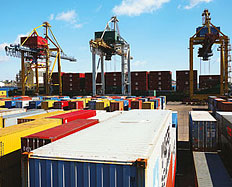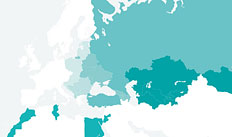Chapter 4
Regional trade integration: benefits and challenges
Regional economic integration can bring multiple benefits.
First, lower tariff and non-tariff trade barriers should increase trade and enhance consumer choice. In the case of the Eurasian Customs Union, the immediate "trade creation" effects would mainly reflect the elimination of administrative barriers as customs checks are removed from internal borders (since most trade between the member countries was already subject to zero customs duties). Improvements in cross-border regional infrastructure might also play an important role.
Second, producers within a regional integration grouping can benefit from increased market size. Market size, in turn, is an important factor facilitating innovation, the fixed costs of which can be spread across a larger customer base.7 At the same time, consumers will also benefit from greater competition in product markets. These effects crucially depend not just on the creation of a single customs area, but also on the elimination of barriers to market access. Important progress has been made in this respect in Belarus, Kazakhstan and Russia where, with a few exceptions, firms have equal access to public procurement contracts in all three countries.
Third, exporting within a regional area may serve as a first step towards the expansion of exports worldwide – by initially building export capacity taking advantage of low tariff and non-tariff barriers within a union, and then leveraging this capability to achieve competitive advantage in exporting to other countries. For Kazakhstan and Russia, developing such export capability is a particularly challenging task given their existing relatively narrow, natural resource-focused export bases.8
Fourth, countries within a regional integration area can build cross-border production chains by leveraging each other's comparative advantages and subsequently exporting the finished product outside that area (see Box 4.1 for an example of such integration in the Association of Southeast Asian Nations). Links through foreign direct investment (FDI) typically play a prominent role in this scenario, as they did in the 1990s when CEB countries became increasingly integrated in European production chains.
Fifth, deeper regional economic integration can help member countries to strengthen their economic and political institutions. As some competencies are delegated to newly created supranational bodies, and other areas of economic policy undergo cross-country synchronisation, the opportunity arises to review and revise laws and regulations and to strengthen their implementation, in turn promoting business environment improvement and liberalisation. Accession to the European Union undoubtedly played a key role in enhancing institutions in the CEB countries, and the longer-term viability of CIS regional integration will depend largely on whether the Eurasian Economic Community can create institutions stronger than those of any of its member states.
Lastly, integration can encourage the liberalisation of services markets, which tend to be subject to greater regulation and protection compared with those for goods (and even within the European Union they remain fragmented to some extent). Nevertheless, in the context of Eurasian integration there is great potential for efficiency gains in these markets which could be realised by lowering entry barriers for firms and investors from other countries.9
Regional economic integration also comes with a number of challenges, the most important of which is to minimise negative effects on economic links with outside countries. Such effects typically occur through trade diversion, whereby a relative change in tariff barriers can divert trade from more efficient external exporters to less efficient ones.12 For example, should the introduction of a common external tariff by a regional bloc result in a relative increase in the import tariff for country A outside the region compared with that for country B inside the region, one would expect an increase in imports from country B and a drop in imports from country A. As a result, however, consumers must buy goods from the less efficient producer.
Concerns about trade diversion have been raised in the context of the Eurasian Customs Union. Its common tariff, which was formulated in the crisis environment of 2009, was also used in part as a tool of industrial policy to promote selected import substitution through an increase in tariffs (for example, in the case of the automotive sector). The common tariff's introduction resulted in significant changes to the import tariff structure in each constituent country, with tariff lines adjusted upwards and downwards. Kazakhstan's schedule underwent the most extensive changes, affecting more than 50 per cent of tariff lines (see Chart 4.1) and mostly in an upward direction. The empirical impact of these changes is examined in the next section.
Source: World Bank (2011).
Note: This chart depicts the change in the average effective tariff rate at the industry level before and after the Customs Union came into force, inclusive of transitional provisions. Total refers to an overall average.
Another concern, and particularly in relation to the Eurasian bloc, is asymmetry. The disparity in the economic size of the largest state, Russia, and that of the other members is perhaps greater than in any other regional economic grouping. Kazakhstan's population and gross domestic product (GDP) are around one-tenth of those of Russia, and those of Belarus are lower still. While comparisons with other integration ventures which include dominant countries (for example, Brazil in Mercosur – see Box 4.2) suggest that the benefits of regional integration are still substantial, asymmetries can become an obstacle. It is important to ensure that the decisions of supranational bodies are implemented by all member countries, and that dispute resolution mechanisms at the supranational level work well.
In a regional union dominated by commodity exporters, a further challenge is to leverage the benefits of economic integration. Partly due to the fact that Kazakhstan and Russia predominantly export oil and other commodities, the Customs Union is less economically integrated than commonly perceived: Belarus and Kazakhstan account for under 7 per cent of Russia's export and import trade, although Belarus, as a net energy importer, sources over half of its total imports from Kazakhstan and Russia. The Gulf Cooperation Council (GCC) is a similar example of a regional economic union dominated by major oil exporters (see Box 4.3). Regional integration does present substantial challenges in the case of outward-oriented commodity exporters (not least the challenge of harmonising approaches to taxation of commodity exports). Nevertheless, these countries can still benefit from cooperation in many areas, including the development of cross-border infrastructure, cross-border investment and the liberalisation of mutual access to services markets.
Lastly, while deeper economic integration may yield substantial benefits, it can also aggravate the macroeconomic vulnerabilities of member states. As production chains become more integrated, shocks to world trade (such as that in 2008) permeate quickly through regional economic blocs. Producers of intermediary goods may be particularly badly affected as suppliers of final goods cut orders and run down their existing stocks of input materials.13 As a result, output contractions can be amplified through close trade linkages and so affect the strength of subsequent recovery.
3 The paradigm was originally developed in the 1930s and is best summarised in Akamatsu (1962). It originally referred to the economic integration in east Asia and the role of Japan.
4 See Menon (1996) for a discussion of the role of MNCs.
5 See Fujita (2001).
6 See Ng and Yeats (1999).
7 See EBRD (2010) for a discussion of the relationship between exports and innovation.
8 See EBRD (2008) and EBRD (2012).
9 See, for instance, Jensen et al. (2007) and Tarr and Volchkova (2010) in the context of Russia.
10 See Olarreaga and Soloaga (1998). See also Laursen (2010) for a discussion of political aspects of integration.
11 See Kume and Piani (2001).
12 The term trade diversion was coined by Viner (1950). See Venables (2003) for a detailed discussion of the issue.
13 See Zavacka (2012) for a discussion of this so-called “bullwhip effect”.







